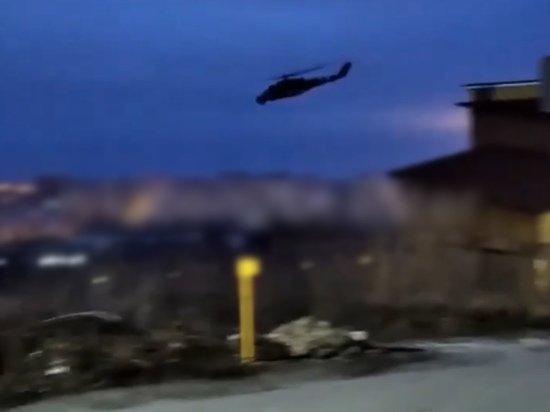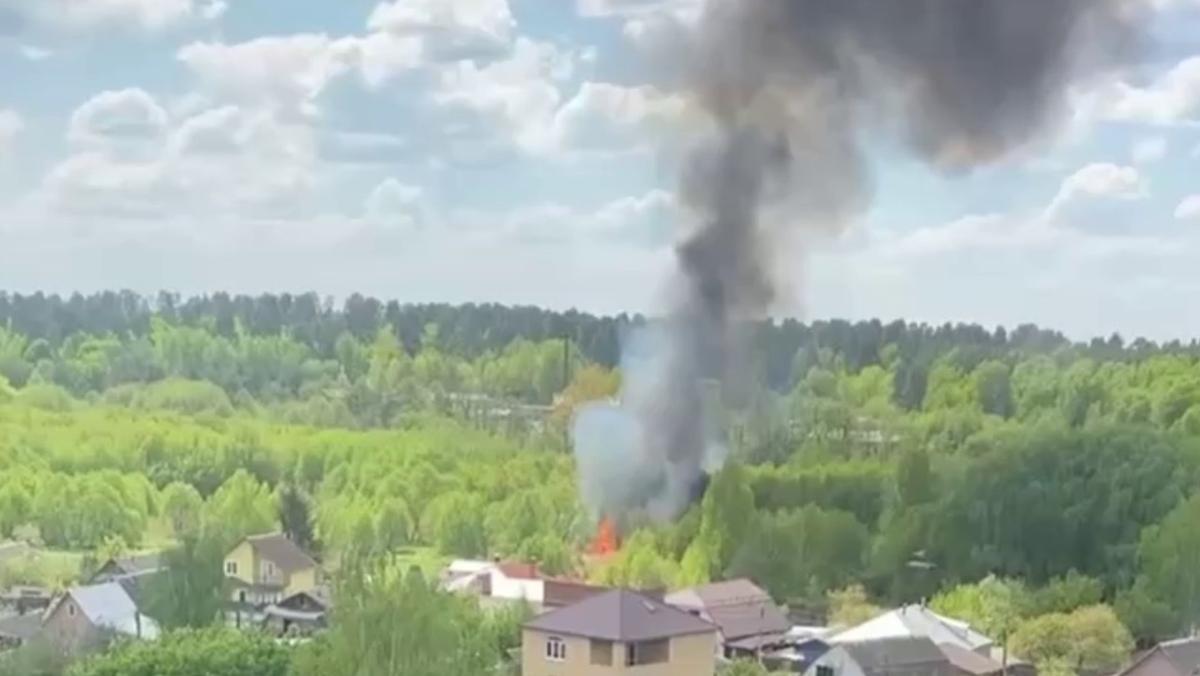Schrödinger’s crash
In the morning of 13 May, Saturday, at least four Russian aircraft crashed in the Bryansk region of the country: two Mi-8 helicopters, a Su-34 fighter bomber, and a Su-35 fighter jet. The crews of all aircraft — three people each in the helicopters, two in the Su-34, and one pilot in the Su-35 — were all killed.
According to Russian journalists, the aircraft were all part of one aviation group. The jet was covering the bomber, while both helicopters were covering the planes using electronic warfare systems and were supposed to evacuate the fighters’ pilots in case something went wrong. The distance between the crash sites and the Ukrainian border is no longer than 45 km.
The Bryansk region governor Alexander Bogomaz reported that five buildings were damaged and one local woman was injured following the crash of a helicopter near the town of Klintsy. We should note that Bogomaz confirmed only the crash of one helicopter.
Military observer Michael Nacke shared on his blog, citing Russian Telegram channels and the information collected by the Orix project, that at least one of the destroyed helicopters of the MTPR-1 modification was equipped with the Rychag-AV electronic warfare system. It suppresses enemy air defence systems using active jamming.
Spokesperson for the Ukrainian Air Force Yurii Ihnat declared that Ukraine’s Armed Forces (AFU) had nothing to do with the crashes, adding however that “Russian air defence” was “involved”. To Ihnat’s knowledge, Russia lost five aircraft that day — two planes and three helicopters.
Michael Nacke claimed that
destroying four aircraft at once is an unprecedented case in modern history
and put forward three main versions of what happened. First of all, according to Nacke, Ukrainian jets could have shot down Russian aircraft using air-to-air missiles. The second version is that the successful destruction could have been the work of a Ukrainian anti-aircraft missile system.
In this context, the surprising thing was that Russia’s Defence Ministry has remained quiet about the incident with catastrophic repercussions for its reputation. It’s as if these helicopters and planes did not exist for the Russian army (and that’s not even mentioning the nine killed personnel, according to the not-yet-official data). Meanwhile, if you look at the ministry’s official pages, the “special military operation” continues successfully, with Russia achieving consistent victories. It was the Defence Ministry’s silence that made the third version popular: according to it, Russian planes and helicopters fell victim to “friendly fire” by Russian air defence.
Friendly fire
Head of PMC Wagner Yevgeny Prigozhin has also hinted at friendly fire by proposing people partake in simple geometry: “Four aircraft, if we draw a circle around the crash sites, then we get a circle with a 40-km diameter. So the circle’s radius is 20 km. And now go online and look up which air defence system could have been located inside this circle, and then draw your own conclusions.” Simple calculations let us know that Prigozhin thinks all of the aforementioned Russian aircraft were attacked from Russia’s territory.
“As far as I know, Ukraine has nothing to do with this,”
Oleksandr Musiyenko, head of the Centre for Military and Legal Studies, tells Novaya-Europe. “We’re talking about sabotage from within the Russian army. According to flight plans, the helicopters and planes were ordered to fly maintaining radio silence which purposefully made them potential friendly fire targets. It’s likely that within Russian law enforcement and military there is a group of people who want the war to end as soon as possible, with Ukraine winning, and for Putin’s regime to collapse.”

Ukrainian helicopter Mi-24 above an oil storage near the Russian city of Belgorod. Photo: VKontakte
Michael Nacke recalls an incident when two Ukrainian Mi-24 helicopters attacked an oil storage and then Russian air defence destroyed a plane belonging to the Russian army in the same region.
“In this war, there were several cases when aerial targets were shot down by friendly fire,” Israeli military expert David Sharp tells Novaya-Europe. “We know of such cases on both sides. It’s clear that
Russian air defence has to always be on heightened alert on the border territories, and this could lead to mistakes made because of nerves.”
“But to imagine that one’s own air defence almost simultaneously attacks four targets flying with a large spread at different altitudes and speeds is mind-boggling. The Russians’ radar screens had to suddenly start showing targets that came out of nowhere in the depth of their own territory. The flight plans are usually coordinated with air defence, and anti-aircraft missile system operators are most likely aware of the planes currently in the air. Even if they have doubts — a “friend or foe” identification turns on which usually doesn’t even let the operators take an aim at a “friendly” target. So I almost entirely reject this version because it would mean that someone has gone crazy.”
According to the Israeli expert, Prigozhin’s version of events — some anti-aircraft missile system in the centre of some unknown circle destroying friendly targets in the 20 km radius — is below any criticism. At the minimum, residents of the quite densely populated area would have noticed a smoke trail left by air defence missiles being launched off the ground.
David Sharp considers the theory about an aerial ambush carried out by Ukrainian fighter jets to be improbable. All planes that the Ukrainian Armed Forces possess today are routinely equipped with Soviet missiles, which have a very limited range. To use them, they would have to engage in close combat, which has not happened in a long time near the Russian-Ukrainian border. There’s a small likelihood that Kyiv was able to modernise its planes to make them equipped to use Western weapon systems. For example, AMRAAM missiles have a range from 120 to 180 km, and they could have hit a target from behind the front line. These missiles have a homing head that allows for fighting air targets effectively. However, Sharp has no knowledge of Kyiv receiving such missiles or successful alteration of Ukrainian planes to be fit for this type of weapon.
The Israeli expert is sure that
the more rational explanation of the crashes is an ambush carried out by Ukraine using one or several long-range anti-aircraft missile systems,
that were transported near the line of contact.
“Both Patriot and SAMP-T systems provided by the allies and old Soviet S-300 systems that reach the target located 75 km away have more than enough range for an attack like this,” says David Sharp. “Anti-aircraft missile system ambushes on enemy planes have been carried out since the 1950s, starting from the Vietnam War. Later on, hidden attacks on air targets were conducted during Arab-Israeli conflicts.”
Ukrainian military expert and colonel in the AFU reserve Roman Svitan also agrees that Russian aircraft became the prey of Ukraine’s air defence that was lying in wait. He claims that Ukraine’s Armed Forces used the same strategy to shoot down a Su-34 bomber in the sky above the occupied city of Yenakiyeve, Donetsk region, this March. “There are a lot of videos online of Russian planes and helicopters getting shelled on 13 May,” Roman Svitan explains to Novaya-Europe. “Some of them show how a missile launched from a land anti-aircraft missile system hits the front half-sphere of a plane or a helicopter; meanwhile, a shell launched from a portable anti-aircraft missile system is aimed at the engine’s heat, and it usually hits the plane’s tail — directly hits the exhaust stream that starts at the nozzle. Precisely when an anti-aircraft missile system is used for an attack is when a cockpit is hit with smallest elements. Under these circumstances, the crew usually dies. Which is exactly what happened this time.”
Roman Svitan explains that the “friend or foe” recognition system does not allow for attacking “friendly” targets. To do so, an anti-aircraft missile system’s operator would have to manually turn off the safety lock. He also agrees with David Sharp about one of the long-range systems possibly being used for the attack: for example, S-300, Patriot, or SAMP-T.
“This whole aviation group, as if on schedule, flew to bomb the Chernihiv and Sumy regions daily using ammunition based on FAB-500,”
explains Roman Svitan. “The fighter jet was covering the bomber, while the helicopters were carrying electronic warfare devices to jam Ukraine’s air defence. Ukrainians were able to intercept this group during one of these flights. In the dark, an anti-aircraft missile system moved closer to the border with its radars turned off. They turned the locators on at the last minute and were able to almost simultaneously intercept at least four targets. After the first four aircraft had been downed, it’s highly likely that a special evacuation helicopter of Russia’s paratroopers service took to the air. This Mi-8, it seems, was also shot down by Ukraine’s Armed Forces. Currently, we are waiting for this information to be confirmed.”
Join us in rebuilding Novaya Gazeta Europe
The Russian government has banned independent media. We were forced to leave our country in order to keep doing our job, telling our readers about what is going on Russia, Ukraine and Europe.
We will continue fighting against warfare and dictatorship. We believe that freedom of speech is the most efficient antidote against tyranny. Support us financially to help us fight for peace and freedom.
By clicking the Support button, you agree to the processing of your personal data.
To cancel a regular donation, please write to [email protected]

